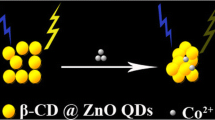In a suitable pH buffer solutions, sodium diethyldithiocarbamate (DDTC) reacts with some divalence metal ions M(II) to form (M–DDTC) n chelate complex nanoparticles, which exhibit different luminescence properties. There is a strongest luminescence peak at 470 nm for the Co(II)–DDTC system, three peaks at 330, 470, and 630 nm for the Cu(II)–DDTC system, three peaks at 420, 470, and 630 nm for the Cd(II)–DDTC system, four peaks at 350, 400, 435, and 470 nm for the Ni(II)–DDTC system, two peaks at 408 and 470 nm for the Pb(II)–DDTC system, two peaks at 415 and 470 nm for the Fe(II)–DDTC system. The different luminescence properties of (M–DDTC) n chelate complex nanoparticles was explained. Under the optimal conditions, the luminescence intensity of (Co–DDTC) n chelate complex nanoparticles at 470 nm (F 470 nm) is linear to Co(II) concentration in the range of 0.012–1.44 μg/mL. The detection limit is 0.0023 μg/mL. A novel luminescence method has been proposed for the determination of cobalt in Vitamin B12 samples, with satisfactory results.






Similar content being viewed by others
REFERENCES
C. W. Chan and S. Nie (1998). Science 281, 2016.
E. Klarreich (2001). Nature 413, 450.
Y. Xie, J. J. Xu, J. S. Yu, and H. Y. Chen (2004). Chin. J. Inorg. Chem. 20, 663.
A. Maali, T. Cardinal, and M. Treguer-Delapierre (2003). Physica E 17, 559.
J. Zhe, Y. C. Wang, and Y. M. Lu (2004). Colloids Surf. A232, 155.
Z. L. Jiang, S. P. Liu, and H. L. Jiang (2002). Chin. J. Appl. Chem. 19, 1133.
Z. L. Jiang, W. E. Yuan, and H. C. Pan (2005). Spectrochim. Acta A 61, 2488.
Z. L. Jiang, F. Z. Liu, S. P. Liu, and X. Lu (2003). Chin. J. Anal. Chem. 31, 1364.
S. Oszwaldowski and J. Jakubowska (2003). Talanta 60, 643.
W. G. Zhu, Q. Jiang, Z. Y. Lu, et al. (2000). Thin Solid Films 363, 167.
W. Wasiak (1995). J. Chromatograph. A 690, 93.
X. Q. Wei, W. G. Zhu, A. L. Yang, et al. (2003). Acta Chim. Sin. 61(3), 388.
Z. L. Jiang, H. C. Pan, and W. E. Yuan (2004). Chin. J. Environ. Chem. 23, 573.
Q. E. Cao, Y. K. Zhao, X. G. Cheng, Z. D. Hu, and Q. H. Xu (1999). Food Chem. 65, 405.
D. T. Burns and P. Hanprasopwattana (1983). Anal. Chim. Acta 151(1), 245.
D. Z. Wang (1985). Organic Reagents and Chemical Analysis. China Geological Press, Beijing, p. 23.
ACKNOWLEDGMENT
The work was supported by the Scientific Foundation of Guangxi province (No. 0575042).
Author information
Authors and Affiliations
Rights and permissions
About this article
Cite this article
Jiang, Z., Sun, S., Liang, A. et al. Luminescence Properties of Metal(II)-Diethyldithiocarbamate Chelate Complex Particles and Its Analytical Application. J Fluoresc 15, 859–864 (2005). https://doi.org/10.1007/s10895-005-0017-0
Published:
Issue Date:
DOI: https://doi.org/10.1007/s10895-005-0017-0




